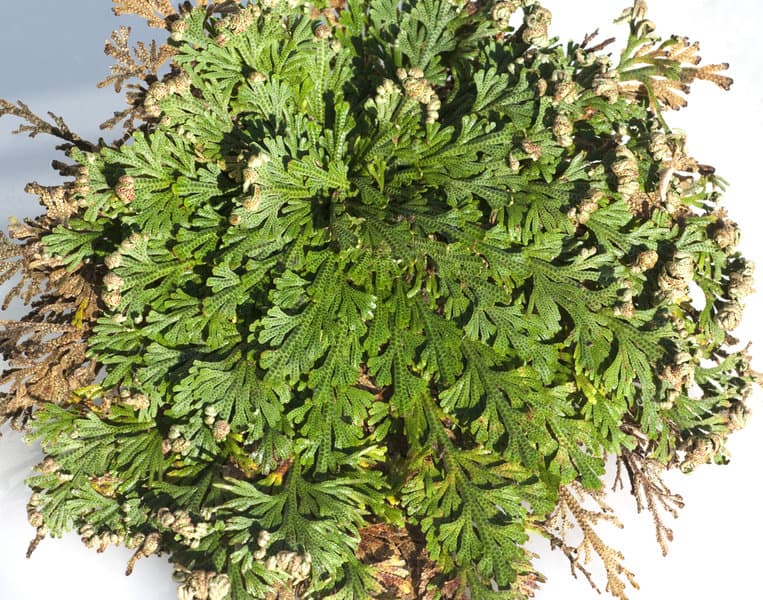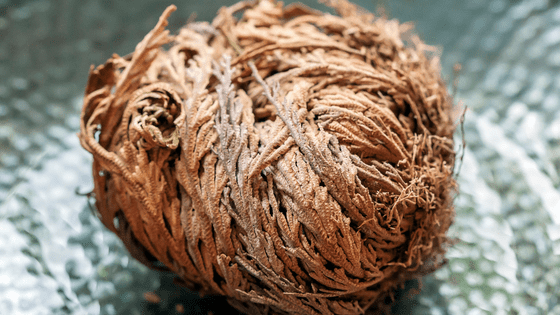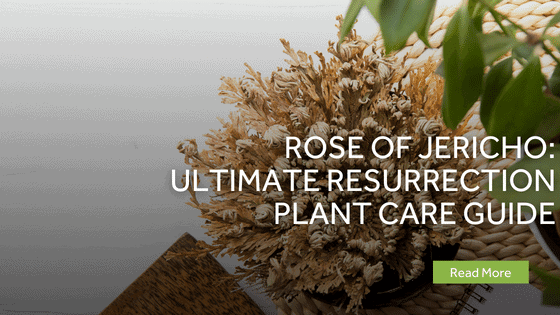The Rose of Jericho plant is a mystery and a wonder at the same time. It’s one of the few plants that ‘comes back to life,’ making it great for anyone, even those who consider themselves a ‘black thumb.’
Table of Contents
Rose of Jericho Overview
The Rose of Jericho plant is from the deserts of the Middle East. It’s built to withstand dry conditions resulting in the nickname ‘the resurrection plant’ or resurrection rose because of its ability to completely dry up but come back to life when watered.
The Jericho Rose plant is from the Brassicaceae family and the Anastatica genus. Its species is A. hierochuntica, the only variety within the species.
The Rose of Jericho plant goes by many names, including The flower of St. Mary, Maryam’s flower, the dinosaur plant, and the white mustard flower, along with its most common nickname, the resurrection plant.
| Family | Brassicaceae |
| Genus | Anastatica |
| Origin | Middle East |
| Nickname | Resurrection Rose or Resurrection Plant |
| Sunlight | Indirect sunlight |
| Watering | Lives in water |
| Soil | Doesn’t require soil |
| Temperature | Room temperature |
| Propagation | Loose cuttings |
| Pests and Diseases | Slugs, snails, and mold growth |
| Toxicity | Toxic to cats (and should be kept away from children and other pets) |

Rose of Jericho Features
The Jericho plant has small, thin branches that spread sporadically throughout the plant with long leaves. The leaves themselves have a strand-like appearance, almost resembling a fern. The plant grows to only about 12 inches tall.
The roots of the Jericho plant are fragile, and the plant produces small, white flowers.
Rose of Jericho Plant Facts
The Rose of Jericho plant has a rich background in religion, science, and literature and is possibly one of the most mysterious plants available today.
Before we get into the history, it’s essential to know that there are two Rose of Jericho plants; however, one is the False Rose of Jericho. Its name is the Selaginella lepidophylla, and it is a true dinosaur plant. It originates from the deserts of Mexico and Arizona. It acts the same as the true rose plant because it dries up and ‘comes back to life’ when watered. However, it’s much easier to find than the true Rose of Jericho plant.
As you can guess, the resurrection plant symbolizes rebirth or resurrection. It also symbolizes longevity and love in some cultures. In addition, many cultures believe the plant can eliminate negative energy, provide good luck, and protect those around it.
Many Christians display the Rose of Jericho plant at Christmas time because they believe it symbolizes Jesus’s death and resurrection and sometimes even his birth.
The Rose of Jericho is used as traditional medicine in the scientific world. It’s used as tea or oil made from seeds, leaves, and flowers. It has helped speed up labor, alleviate menstrual cramps, and decrease arthritis pain and symptoms of the common cold.
Rose of Jericho Care Guide
Caring for the Rose of Jericho plant is relatively easy since it’s considered a plant that’s hard to kill. It can last without water for years, and once it finds water, it resurrects itself, hence its name, the Resurrection plant.
Ideal Growing Place
The Rose of Jericho plant grows best indoors. Even though it originated in the desert, it doesn’t do well with extreme temperature changes. Keeping it indoors allows you to control the light, temperature, and humidity levels to provide it proper care.
You May Also Like: How to Fix a Brown Patch in Your Lawn: 6 Steps
Water
The watering requirements will surprise you as you learn how to care for the Rose of Jericho. First, the plant lives in a dish with water and a few pebbles. It doesn’t need soil. You let it rest in the water, especially after it has gone dormant, so it can come back to life.
The plant lives in the water most of the time, but you must change the water daily. While it’s best to use distilled water, if you don’t have access to it, you can let tap water sit out overnight to eliminate any chlorine and toxins.
Every couple of days, give it a ‘water break’ to avoid the accumulation of moss. Then, once a month, let the plant completely dry up and then revive it again.
If the leaves look too dry, you can lightly mist them with a spray bottle.
Sunlight
The resurrection plant needs indirect light. So make sure it gets adequate light, but not direct sunlight. If it’s lacking light, the leaves will start to curl, which is your sign to move it unless you plan to store it away and put it in dormancy. If that’s the case, put it in a dark cupboard so it goes completely dormant.
Temperature
The Rose of Jericho plant does best at room temperature but can survive at any temperature between 41 and 95 degrees Fahrenheit. It can survive frost too, but it’s not recommended.
The most significant factor in Rose of Jericho care is to avoid extreme temperature changes. If you have it inside, keep it away from drafts, including those from windows, the furnace, and the air conditioner.
Soil
The Jericho plant doesn’t need soil. It can survive in just water for its entire life. But that doesn’t mean you can’t put it in soil. The true Jericho Rose plant can be planted in soil and become even fuller and richer.
The false Rose of Jericho plant can also be planted in soil; however, it must first develop roots in Jericho water in a shallow dish.
Humidity
Luckily, the Rose of Jericho care doesn’t include much fuss about humidity. That’s because it spends most of its time in water, which creates the perfect environment for the plant. However, if you have it indoors, keep an eye on it. If the leaves seem to wilt or the plant isn’t healthy, occasionally spritz it with water to increase the humidity levels.
Fertilizer
This Mustard family plant doesn’t require fertilizer. As long as it has fresh water and indirect light, it has what it needs to grow.
Pinching/Pruning
Fortunately, the Resurrection fern doesn’t require any pruning. The only exception is if there are dead or decayed leaves. You should remove them immediately to avoid affecting the other healthy part of the plant.
Potting and Re-potting
The Rose of Jericho plant doesn’t need a pot or soil. It can live in a shallow dish with little water to cover the roots.
Growth Zone
The Rose of Jericho plant grows the best in USDA zones 8a to 11.
Common Pests, Toxins, Diseases & Other Problems
Luckily, the Rose of Jericho plant doesn’t suffer from many diseases or pests. Its most significant issue is a lack of humidity. Sometimes you might deal with a snail or slug too. If you notice snails or slugs, remove them from the plant and prune any damaged areas, but they rarely cause damage. It’s not necessary to use pesticides on the plant.
It’s important to note that the Rose of Jericho is toxic. It’s especially harmful to cats but should be kept out of reach of any children or animals.
How to Propagate Rose of Jericho
Propagating the Rose of Jericho is simple. It lives up to its name, the Ressurection Plant. Just place a few cuttings of a dormant plant in water with some loose pebbles, letting the roots soak. The plant will come to life, and you’ll have another Jericho plant to enjoy.
Rose of Jericho Mature Timeline
It takes only a few days for the Resurrection plant to show new growth once you split it. Just make sure you use lukewarm water when replanting to give it the best chance.
Rose of Jericho FAQ

How Old Does Rose of Jericho Have to Be Before They Bloom?
Once the Rose of Jericho plant is completely hydrated, it can bloom flowers. It doesn’t have to be a certain age.
How Long Does It Take for a Rose of Jericho to Open?
A dormant Rose of Jericho can open in as little as four hours when placed in distilled, lukewarm water.
How Long Does It Take for a Rose of Jericho to Turn Green?
It takes a healthy but dormant dried rose of Jericho four hours to turn green. It might take a few days to look like a healthy plant, but you should know if it will survive within hours.
Is Rose of Jericho a Fast Grower?
Since the Rose of Jericho only grows to about 12 inches, it grows fast for its type. But, first, it needs the proper environment to grow, which means adequate water.
What Are Some Rose of Jericho Plant Benefits?
Rose of Jericho has a reputation for medicinal uses. While there aren’t any formal studies proving it, legend has it that they contain disease-fighting flavonoids, including chlorogenic acid, quercetin, kaempferol, and luteolin. These compounds may help fight cancer and arthritis pain and regulate blood pressure and blood sugar levels.
Why Is the Jericho Rose Called the Resurrection Flower?
The desert plant is named the Resurrection Flower because it can completely dry up like a tumbleweed and revive itself once placed back in the water. Some last as long as seven years, dry up and come back to life.
What Does the Rose of Jericho Flower Smell Like?
If you notice that your Rose of Jericho plant smells musty or ‘off,’ it could be a sign of infection. Make sure you give it clean water daily and give it a break from water at least once a month to prevent this.
What Is the Difference Between the Rose of Jericho and the False Rose of Jericho?
The False Rose of Jericho Rose plant is native to the Chihuahuan desert and part of the spikemoss family. It is the most common Rose of Jericho plant that people have as houseplants and is easier to grow.
Where to Buy Rose of Jericho?
You can find Rose of Jericho on Etsy, Amazon, and specialty nursery websites.
How Long Do Rose of Jericho Blooms Last?
When in water, the Rose of Jericho has tiny white flower blooms that last as long as it’s in water. When it is dormant, there aren’t any flowers.
What Kind of Pot Is Suitable for a Rose of Jericho Plant?
The Rose of Jericho plant doesn’t need a pot. It can survive in a small dish with a few pebbles and fresh water.
Is Rose of Jericho Rare?
It is easier to find the false Rose of Jericho plant than the traditional one which is considered rare.
Is the Rose of Jericho Poisonous
The Rose of Jericho can be poisonous, especially to cats.
Is Rose of Jericho Toxic to Pets and Humans?
Because the plant is toxic for cats, it’s best to keep it away from children and pets to be safe.
The Bottom Line
The Rose of Jericho can be an excellent plant for anyone. But, make sure to keep it out of reach of children and pets. With the proper steps, you can have fun with the rare plant that resurrects and provides us with a beautiful reminder that life is good.
Last Updated on September 3, 2022 by Gustaf Johansson




